 Children inherently are fascinated with exploring their worlds and using their imaginations, the ability to believe in the impossible or to transport oneself into unique and strange environments, in their everyday lives. Books are often a venue that allows their imaginations to soar. Fantasy books invite the reader into worlds with talking animals, strange creatures, and unbelievable possibilities. Science fiction allows readers to believe in the possible. Children and teens are naturally curious and like to think of the possibilities of the world around them. Fantasy and science fiction books allow children to go beyond the boundaries of their worlds and view the worlds through eyes of others and to explore fantastical worlds and possibilities. With the boom of picture books and middle school novels, and the continued popularity of dystopian fiction, a number of books in these genres have stood out in the first half of 2013. Being aware of standout titles will help these novels make their way into the hands of children. ReadWriteThink offers a wide range of lesson plan ideas and activities dealing with the use of fantasy and science fiction books for all grade levels.
Children inherently are fascinated with exploring their worlds and using their imaginations, the ability to believe in the impossible or to transport oneself into unique and strange environments, in their everyday lives. Books are often a venue that allows their imaginations to soar. Fantasy books invite the reader into worlds with talking animals, strange creatures, and unbelievable possibilities. Science fiction allows readers to believe in the possible. Children and teens are naturally curious and like to think of the possibilities of the world around them. Fantasy and science fiction books allow children to go beyond the boundaries of their worlds and view the worlds through eyes of others and to explore fantastical worlds and possibilities. With the boom of picture books and middle school novels, and the continued popularity of dystopian fiction, a number of books in these genres have stood out in the first half of 2013. Being aware of standout titles will help these novels make their way into the hands of children. ReadWriteThink offers a wide range of lesson plan ideas and activities dealing with the use of fantasy and science fiction books for all grade levels.
GRADES K-3
Becker, Aaron. (2013). Journey. Somerville, MA: Candlewick Press.
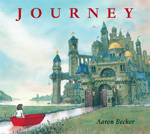 Debut author Aaron Becker takes us on a magical journey in his upcoming picture book Journey. Bored at home, a young girl draws a door on her bedroom wall that opens into a magical land—an strange land filled with wonders, danger, and the promise of a great adventure. With the help of her trusty red marker, the girl creates a boat, a balloon, and a magical carpet that whisk her on her journey to the unknown. In the midst of her exploring she is captured by an evil emperor and must find a way to free herself and make her way home. This wordless book, filled with washes of colors and intricate line drawings, shares the story of an ordinary girl on an anything-but-ordinary adventure.
Debut author Aaron Becker takes us on a magical journey in his upcoming picture book Journey. Bored at home, a young girl draws a door on her bedroom wall that opens into a magical land—an strange land filled with wonders, danger, and the promise of a great adventure. With the help of her trusty red marker, the girl creates a boat, a balloon, and a magical carpet that whisk her on her journey to the unknown. In the midst of her exploring she is captured by an evil emperor and must find a way to free herself and make her way home. This wordless book, filled with washes of colors and intricate line drawings, shares the story of an ordinary girl on an anything-but-ordinary adventure.
- Melanie Koss, Northern Illinois University
Brown, Peter. (2013). Mr. Tiger Goes Wild. NY: Little, Brown Books for Young Readers.
 Author/Illustrator Peter Brown does it again! Brown’s latest picture book shares the delightful story of Mr. Tiger, a Victorian tiger bored with his prim and proper life. He longs for excitement, friendship, and fun, and he knows just how to get it—he goes wild! Be prepared for a shocking spread right in the middle of the book, as Mr. Tiger reaches his height of capers. Brown’s style continues to evolve, with a combination of pencil drawings, manipulated construction paper, and wood borders that lend an old-world charm. His use of color make Mr. Tiger stand out in all his glory against a black and white background, with hand lettered speech balloons that beg to be read aloud.
Author/Illustrator Peter Brown does it again! Brown’s latest picture book shares the delightful story of Mr. Tiger, a Victorian tiger bored with his prim and proper life. He longs for excitement, friendship, and fun, and he knows just how to get it—he goes wild! Be prepared for a shocking spread right in the middle of the book, as Mr. Tiger reaches his height of capers. Brown’s style continues to evolve, with a combination of pencil drawings, manipulated construction paper, and wood borders that lend an old-world charm. His use of color make Mr. Tiger stand out in all his glory against a black and white background, with hand lettered speech balloons that beg to be read aloud.
- Melanie Koss, Northern Illinois University
GRADES 4-5
Healy, Christopher. (2013). The Hero’s Guide to Storming the Castle. NY: HarperCollins.
 In this sequel to The Hero’s Guide to Saving Your Kingdom, Princes Liam, Frederic, Duncan, and Gustav are back in another rollicking tale. Now that the countryside is safe from the evil witch, the League of Princes now have to keep a sword with magical powers from getting into the hands of evil warlords who want the object for their own twisted purposes—world domination. But the sword is hidden in the witch’s castle, which they must storm once again. This fractured fairy tale once again provides the male perspective of commonly told tales, and is packed with twists, turns, and a heaping dose of humor. Fans of the first book will surely be just as please with the second, and definitely ready for more.
In this sequel to The Hero’s Guide to Saving Your Kingdom, Princes Liam, Frederic, Duncan, and Gustav are back in another rollicking tale. Now that the countryside is safe from the evil witch, the League of Princes now have to keep a sword with magical powers from getting into the hands of evil warlords who want the object for their own twisted purposes—world domination. But the sword is hidden in the witch’s castle, which they must storm once again. This fractured fairy tale once again provides the male perspective of commonly told tales, and is packed with twists, turns, and a heaping dose of humor. Fans of the first book will surely be just as please with the second, and definitely ready for more.
- Melanie Koss, Northern Illinois University
Mass, Wendy. (2013). Pi in the Sky. NY: Little, Brown Books for Young Readers.
 What happens when you mix a middle grade fantasy novel with physics, time, space, and planets across the entire universe? Pi in the Sky, Wendy Mass’s latest novel. Joss, the seventh son of the Supreme Overlord of the Universe, fades a bit into the woodwork. All of his older brothers excel at everything they do, and he is left to deliver pies. Although these aren’t just any pies, it is still not the most glamorous job. But when Earth suddenly disappears, Joss is called on to do more than deliver pies. He must find Earth and restore it to its place in the universe, not the easiest task. With the help of Annika, a quirky girl from Earth, Joss goes on his once-in-a-lifetime mission. Full of humor, science, twists, and turns, Mass’s novel will challenge lovers of galaxies and pies and push them to new heights. Read an interview about the book on IRA's Engage blog, one with School Library Journal, and another at authorlink.
What happens when you mix a middle grade fantasy novel with physics, time, space, and planets across the entire universe? Pi in the Sky, Wendy Mass’s latest novel. Joss, the seventh son of the Supreme Overlord of the Universe, fades a bit into the woodwork. All of his older brothers excel at everything they do, and he is left to deliver pies. Although these aren’t just any pies, it is still not the most glamorous job. But when Earth suddenly disappears, Joss is called on to do more than deliver pies. He must find Earth and restore it to its place in the universe, not the easiest task. With the help of Annika, a quirky girl from Earth, Joss goes on his once-in-a-lifetime mission. Full of humor, science, twists, and turns, Mass’s novel will challenge lovers of galaxies and pies and push them to new heights. Read an interview about the book on IRA's Engage blog, one with School Library Journal, and another at authorlink.
- Melanie Koss, Northern Illinois University
Graff, Lisa. (2013). A Tangle of Knots. NY: Penguin.
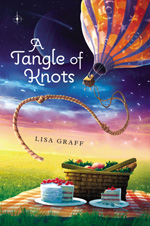 A twist between Savvy and Criss Cross, A Tangle of Knots combines characters with special magical abilities with the intricacies of everyday life. Eleven-year-old Cady is the last remaining orphan in Miss Mallory’s Home for Lost Girls. Talents range, and Cady’s is her ability to bake the perfect cake just right for a person in need. But how can baking save the day? After an air balloon crashes into their building rendering it uninhabitable, Miss Mallory’s charges must move into the Lost Luggage Emporium, a strange place with lost luggage, a Talent Thief, and a woman who lost her voice. The lives of the girls and those that live in the Emporium entwine and mysteries unravel as Cady realizes she might just find out what happened to her missing parents. Told from the third-person perspectives from multiple characters, readers work to put together the puzzle of how the characters’ lives intersect and are led to wonder if there is such a thing as fate. Read more about author Lisa Graff on the Engage blog.
A twist between Savvy and Criss Cross, A Tangle of Knots combines characters with special magical abilities with the intricacies of everyday life. Eleven-year-old Cady is the last remaining orphan in Miss Mallory’s Home for Lost Girls. Talents range, and Cady’s is her ability to bake the perfect cake just right for a person in need. But how can baking save the day? After an air balloon crashes into their building rendering it uninhabitable, Miss Mallory’s charges must move into the Lost Luggage Emporium, a strange place with lost luggage, a Talent Thief, and a woman who lost her voice. The lives of the girls and those that live in the Emporium entwine and mysteries unravel as Cady realizes she might just find out what happened to her missing parents. Told from the third-person perspectives from multiple characters, readers work to put together the puzzle of how the characters’ lives intersect and are led to wonder if there is such a thing as fate. Read more about author Lisa Graff on the Engage blog.
- Melanie Koss, Northern Illinois University
Saunders, Kate. (2013). The Whizz Pop Chocolate Shop. NY: Delacorte.
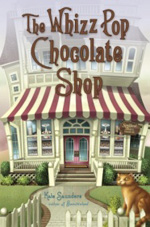 Eleven-year-old twins Oz and Lily’s family inherits an old London house and the mysterious old shop downstairs. The house used to be owned by Oz and Lily’s eccentric great uncles, who were great chocolate makers. When they move into the house, they learn that the house, chocolate recipes, and their uncles aren’t all that they seem. The twins wind up in the middle of a wild plot and must save a chocolate recipe from evil villains who wish to steal the recipe and destroy the world. With the help of an odd assortment of characters, including a hilarious immortal rat and an elephant’s ghost, the story will keep you guessing as it leads to its unexpected conclusion.
Eleven-year-old twins Oz and Lily’s family inherits an old London house and the mysterious old shop downstairs. The house used to be owned by Oz and Lily’s eccentric great uncles, who were great chocolate makers. When they move into the house, they learn that the house, chocolate recipes, and their uncles aren’t all that they seem. The twins wind up in the middle of a wild plot and must save a chocolate recipe from evil villains who wish to steal the recipe and destroy the world. With the help of an odd assortment of characters, including a hilarious immortal rat and an elephant’s ghost, the story will keep you guessing as it leads to its unexpected conclusion.
- Melanie Koss, Northern Illinois University
de Lint, Charles. (2013). The Cats of Tanglewood Forest. Illus. by Charles Vess. NY: Little, Brown Books for Young Readers.
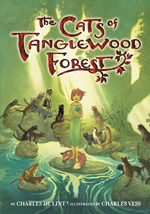 Based on their 2003 picture book A Circle of Cats, de Lint and Vess have created an illustrated novel that beautifully pairs words and pictures into an enchanting whole. Lillian Kindred spends her days roaming Tanglewood Forest, a forest she believes is magical although she has never encountered magic in her life. One day, as she naps, she is bitten by a poisonous snake and saved by magical cats that turn her into a kitten. Together with the cats, a fox, and other woodland creatures, Lillian goes on an adventure to find her way back to being a regular girl. Vess’s illustrations are not to be missed. They appear throughout the book in full color spreads, and are full of details that enhance the richness of de Lint’s words. As an extra surprise, peek below the dust jacket for another stunning piece of Vess’s art. This coming-of-age story details the journey of one girl and asks the reader to question the idea of destiny or if we shape our own lives.
Based on their 2003 picture book A Circle of Cats, de Lint and Vess have created an illustrated novel that beautifully pairs words and pictures into an enchanting whole. Lillian Kindred spends her days roaming Tanglewood Forest, a forest she believes is magical although she has never encountered magic in her life. One day, as she naps, she is bitten by a poisonous snake and saved by magical cats that turn her into a kitten. Together with the cats, a fox, and other woodland creatures, Lillian goes on an adventure to find her way back to being a regular girl. Vess’s illustrations are not to be missed. They appear throughout the book in full color spreads, and are full of details that enhance the richness of de Lint’s words. As an extra surprise, peek below the dust jacket for another stunning piece of Vess’s art. This coming-of-age story details the journey of one girl and asks the reader to question the idea of destiny or if we shape our own lives.
- Melanie Koss, Northern Illinois University
GRADES 6-8
Blakemore, Megan Frazer. (2013). The Water Castle. NY: Bloomsbury.
 After Ephraim Appledore-Smith’s father had a stroke, his family moves to the mysterious town of Crystal Springs, a town where everyone is just a bit smarter and stronger. They move into his family’s ancestral home, the Water Castle, a stone building on a hill with hidden rooms, mysterious passageways, and a secret past. Mallory’s family has always been the caretakers of the castle and guardians of its secret: a connection to the elusive fountain of youth. But since her mother left she has lost her belief in magic. Will’s family has always been at war with the Appledore family, and he doesn’t like the new kid. But the three inexplicably come together to investigate the secrets of the castle. Blakemore’s writing shares the thoughts of all three characters, intermixed with journal entries from a long ago castle resident. She challenges the reader to decide; do they believe in magic? Read about author Megan Frazer Blakemore's writing process on the Engage blog.
After Ephraim Appledore-Smith’s father had a stroke, his family moves to the mysterious town of Crystal Springs, a town where everyone is just a bit smarter and stronger. They move into his family’s ancestral home, the Water Castle, a stone building on a hill with hidden rooms, mysterious passageways, and a secret past. Mallory’s family has always been the caretakers of the castle and guardians of its secret: a connection to the elusive fountain of youth. But since her mother left she has lost her belief in magic. Will’s family has always been at war with the Appledore family, and he doesn’t like the new kid. But the three inexplicably come together to investigate the secrets of the castle. Blakemore’s writing shares the thoughts of all three characters, intermixed with journal entries from a long ago castle resident. She challenges the reader to decide; do they believe in magic? Read about author Megan Frazer Blakemore's writing process on the Engage blog.
- Melanie Koss, Northern Illinois University
Black, Holly. (2013). Doll Bones. NY: Simon & Schuster.
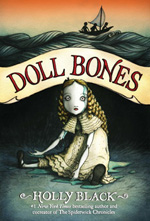 Consistent with her previous books, Black’s newest novel is just as creepy and suspenseful and does not disappoint. Three friends, Zach, Poppy, and Alice, spent their childhoods playing in a world of warriors, mermaids, pirates, and most of all, the Great Queen, a haunted china doll. But in middle school, Zach quits playing until Poppy begins to be haunted by dreams of the Queen. Together the three seek to lay the Doll Queen’s bones to rest. Sinister traps await the trio, leading the reader to wonder if the doll is just a toy or something real and dangerous. This novel is scary, spooky, and has just enough reality to make one stay up at night. Read more about Holly Black in this Engage blog interview.
Consistent with her previous books, Black’s newest novel is just as creepy and suspenseful and does not disappoint. Three friends, Zach, Poppy, and Alice, spent their childhoods playing in a world of warriors, mermaids, pirates, and most of all, the Great Queen, a haunted china doll. But in middle school, Zach quits playing until Poppy begins to be haunted by dreams of the Queen. Together the three seek to lay the Doll Queen’s bones to rest. Sinister traps await the trio, leading the reader to wonder if the doll is just a toy or something real and dangerous. This novel is scary, spooky, and has just enough reality to make one stay up at night. Read more about Holly Black in this Engage blog interview.
- Melanie Koss, Northern Illinois University
Baucom, Ian. (2013). Through the Skylight. Illus. by Justin Gerard. NY: Atheneum.
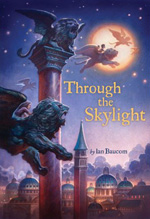 Jared, Shireen, and Miranda have moved to Venice with their family while their professor father is there to do research. Bored, they explore shops in the city and are given presents and a strange book from an old shopkeeper. The gifts bring them great and unexpected powers, and combined with the story found in the pages of the old book, the trio go on an adventure to save three others who live centuries ago. Rashid, Maria, and Francesca were kidnapped and will be sold into child slavery long before during the Middle Ages. Jared, Shireen, and Miranda, with their newfound powers, are the only ones who can save them. Told through stories that intertwine, readers travel from the present to the past and the lives of all six children are at stake. Lending an air of mystery and history are embedded translations of pages of the old book, which move the story on by providing extra bits of information necessary for the trio to solve their quest.
Jared, Shireen, and Miranda have moved to Venice with their family while their professor father is there to do research. Bored, they explore shops in the city and are given presents and a strange book from an old shopkeeper. The gifts bring them great and unexpected powers, and combined with the story found in the pages of the old book, the trio go on an adventure to save three others who live centuries ago. Rashid, Maria, and Francesca were kidnapped and will be sold into child slavery long before during the Middle Ages. Jared, Shireen, and Miranda, with their newfound powers, are the only ones who can save them. Told through stories that intertwine, readers travel from the present to the past and the lives of all six children are at stake. Lending an air of mystery and history are embedded translations of pages of the old book, which move the story on by providing extra bits of information necessary for the trio to solve their quest.
- Melanie Koss, Northern Illinois University
GRADES 9-12
Yancey, Rick. (2013). The 5th Wave. NY: Penguin.
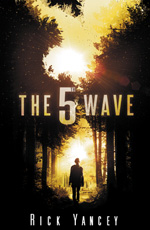 Award winning author Rick Yancey’s latest book will have you on the end of your seat and leaving the light on. Aliens have attacked the Earth and only few have survived. Survival might not be a good thing. After the 1st wave, darkness covers the land. After the 2nd wave, the few lucky ones escape, and after the 3rd wave only the unlucky survive. The 4th wave brings the rule to trust no one. Cassie is a survivor but the 5th wave is upon her. She’s alone and running from the bad guys, who look human but are really in disguise. When she meets Evan, she must decide to whether or not to trust. Another book told with alternating narrators, The 5th Wave takes you into the mind of those who wish to persevere and what they will sacrifice for survival.
Award winning author Rick Yancey’s latest book will have you on the end of your seat and leaving the light on. Aliens have attacked the Earth and only few have survived. Survival might not be a good thing. After the 1st wave, darkness covers the land. After the 2nd wave, the few lucky ones escape, and after the 3rd wave only the unlucky survive. The 4th wave brings the rule to trust no one. Cassie is a survivor but the 5th wave is upon her. She’s alone and running from the bad guys, who look human but are really in disguise. When she meets Evan, she must decide to whether or not to trust. Another book told with alternating narrators, The 5th Wave takes you into the mind of those who wish to persevere and what they will sacrifice for survival.
- Melanie Koss, Northern Illinois University
Charbonneau, Joelle. (2013). The Testing. NY: Houghton Mifflin.
 Reminiscent of The Hunger Games, Joelle Charbonneau creates a post-war world with a strong government who has created colonies to help sustain the world. Upon graduation day, colony residents are chosen for The Testing, a rigorous United Commonwealth Program that only the best and brightest are chosen for. Cia is from Five Lakes Colony, and no one from her colony has been chosen for The Testing in years, her greatest dream. When Cia and a fellow colonist Tomas are chosen, Cia must leave her colony with the words of her father, “Trust no one,” ringing in her ears. The Testing puts the students through dangerous mental and physical tests, and only the strongest survive. Tomas and Cia form an alliance with the hopes of making it to the next stage of the program. Charbonneau fleshes out Cia’s character and gives us a strong, confident protagonist to root for. Readers will anxiously be waiting for book 2, Independent Study, coming out in January 2014.
Reminiscent of The Hunger Games, Joelle Charbonneau creates a post-war world with a strong government who has created colonies to help sustain the world. Upon graduation day, colony residents are chosen for The Testing, a rigorous United Commonwealth Program that only the best and brightest are chosen for. Cia is from Five Lakes Colony, and no one from her colony has been chosen for The Testing in years, her greatest dream. When Cia and a fellow colonist Tomas are chosen, Cia must leave her colony with the words of her father, “Trust no one,” ringing in her ears. The Testing puts the students through dangerous mental and physical tests, and only the strongest survive. Tomas and Cia form an alliance with the hopes of making it to the next stage of the program. Charbonneau fleshes out Cia’s character and gives us a strong, confident protagonist to root for. Readers will anxiously be waiting for book 2, Independent Study, coming out in January 2014.
- Melanie Koss, Northern Illinois University
Young, Suzanne. (2013). The Program. NY: Simon & Schuster.
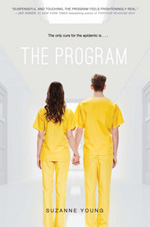 Suicide has become a national epidemic, and teens that exhibit signs of depression are immediately placed in The Program, a proven course of treatment to cure depression and prevent suicide. However, the cure also entails a complete wipe of memories. Sloane knows she is under constant surveillance at home and in school, and fights to keep her feelings hidden to avoid this fate. Her parents have already lost one child to The Program, and she refuses to be the second. The only person Sloane feels safe around is her boyfriend James, but they are both fighting symptoms of depression. Together, Sloane and James fight not only society but also themselves.
Suicide has become a national epidemic, and teens that exhibit signs of depression are immediately placed in The Program, a proven course of treatment to cure depression and prevent suicide. However, the cure also entails a complete wipe of memories. Sloane knows she is under constant surveillance at home and in school, and fights to keep her feelings hidden to avoid this fate. Her parents have already lost one child to The Program, and she refuses to be the second. The only person Sloane feels safe around is her boyfriend James, but they are both fighting symptoms of depression. Together, Sloane and James fight not only society but also themselves.
- Melanie Koss, Northern Illinois University
These reviews are submitted by members of the International Reading Association's Children's Literature and Reading Special Interest Group (CL/R SIG) and are published weekly on Reading Today Online. The International Reading Association partners with the National Council of Teachers of English and Verizon Thinkfinity to produce ReadWriteThink.org, a website devoted to providing literacy instruction and interactive resources for grades K–12.